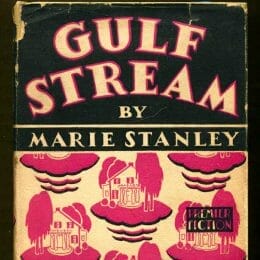Marie Layet Sheip (Marie Stanley)
Marie Layet Sheip (1885-1936), a native of Mobile, is remembered for a single work, the novel Gulf Stream, about three generations of black women and interracial relationships. She wrote the book under the pen name Marie Stanley.
Born on April 13, 1885, the only child of a socially prominent Mobile couple, George and Josephine Layet, Marie lived with her maternal grandmother after she was orphaned at a young age. Her grandmother died just before Marie turned 16, and she then went to live with relatives in Ohio and New Jersey, returning to Mobile when she was 24.
In 1917, she married Stanley Sheip who was a member of a wealthy Mobile family. The couple had no children; Sheip instead poured her energy into the Mobile Little Theatre (of which she was a cofounder), her 17-acre estate in Spring Hill where she entertained a literary circle, and her collection of Mobiliana. Her husband encouraged Marie to complete a novel on which she had been working about interracial relationships and marriage. The pen name she adopted—Marie Stanley—was a combination of their two first names. Sheip also was an accomplished visual artist, having studied with renowned American painter William Merritt Chase while in New Jersey.
When Gulf Stream was published in 1930, national reviews were generally favorable, with reviewers noting that the novel was an impressive first publication. The subject of interracial relationships captured reviewers’ attention, but the novel was criticized for being too allegorical. Locally, it created an outrage among the inhabitants of Sand Town (an African American neighborhood in Mobile used as the setting of the novel) because of objections to the portrayal of the local black dialect, notably in a book by a white author.
The novel’s main protagonists are distinctive in their characterization. Three of the major characters represent generations of black women, each reacting to their race differently. The protagonist Adele, light-skinned, wants to pass for white; her aunt, Delly Childers, accepts her color; and Delia, her light-skinned daughter by a white man, celebrates her blackness and is determined to marry a black man in defiance of her mother’s plans for her. The title of the novel is symbolic: African American culture in the larger American society is likened to the Gulf Stream, which keeps its distinctive qualities as it flows through other waters. The high point of the story occurs when Adele turns back from killing herself in the Gulf.
Marie Sheip died in 1937 in Apalachicola, Florida, upset that her manuscript for a new novel, Penhazard, had been rejected by her publisher.
Further Reading
- Beidler, Philip D. “Introduction.” Gulf Stream. Tuscaloosa: University of Alabama Press, 1993.
- Delaney, Caldwell. “Preface.” Gulf Stream. Tuscaloosa: University of Alabama Press, 1993.






